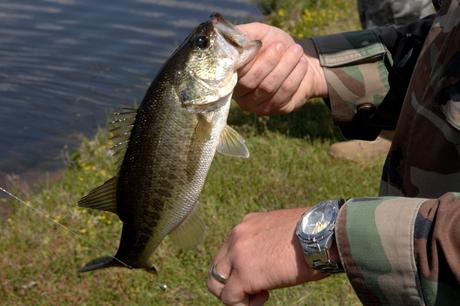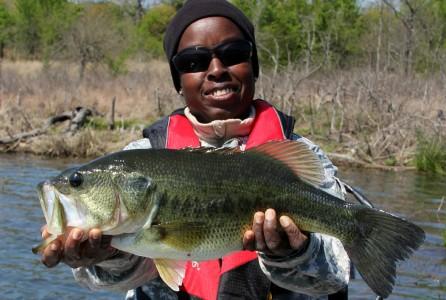Original Article: Spotted Bass vs Largemouth Bass
 Photo by Brittany Barker
Photo by Brittany Barker
If you read our recent article on how to fly fish for bass, then you’re probably geared up and ready to hit the water. However, as you learn more or if you’ve already gotten out on the water, you’ll start to realize there are a few different types of bass. Here we will discuss the Spotted Bass vs the Largemouth Bass.
The differences between a Spotted Bass and a Largemouth bass can be easy to identify if you know what you’re looking for, but these differences can also be pretty subtle.
Spotted bass and Largemouth bass are some of the most popular freshwater game fish and being that they taste great on the barbeque or even an open campfire, many anglers play for keeps instead of playing catch and release.
With limit sizes varying from state to state, take note of these key differences so that you can be sure you’re adhering to your state’s regulations and aren’t breaking any rules when you take that fish home for dinner.
Common facts about Spotted and Largemouth Bass
These two species of bass share the same waters and are great fun for anglers all across the country. This can add some great variation to your fishing trip, so it’s equally important to understand their similarities so you’ll know when you might encounter both species in the same waters.
Spotted Bass and Largemouth Bass share a dark green color and are similar in size and shape.
They are native to freshwaters in and around the eastern and central United States. You can find both species in waters from Georgia to Virginia, with the exception of the Gulf states.
These fish provide a great opportunity for novice fishermen and experts alike, with their predictable feeding habits, openness to different types of lures and leaders, strong hits, and exciting action on the line.

Key Differences Between Spotted Bass vs Largemouth Bass
Now that you are aware of their similarities, let’s go over the many ways we can differentiate between the two when we find ourselves in waters occupied by both Spotted and Largemouth bass.
Physical Differences
With their dark green color and similar size and shape, the way to tell these fish apart is by key features found on their jaw, cheek scales, dorsal fins, tongue, and belly markers:
Spotted Bass
- Jawline does not extend past the eye line.
- Smaller cheek scales than those seen on the rest of their body.
- The Spotted bass gets its name from the lateral line of dark-spotted scales that stretches across their side. This line is irregular due to the spotted coloration of their scales, however, its dark color is much more distinguishable than that of the Largemouth.
- The darker spots of the Spotted bass will fade towards their belly, revealing white scales on their lower bodies.
- A slightly less distinguishable feature is the coarse rectangular patch on the center of the Spotted bass’ tongue.
- The most distinguishable feature between these two fish is their dorsal fin. The Spotted bass boasts a gently curved spine that is clearly connected to its posterior spine.
- Generally smaller and only grow to be 12-17 inches.
- Average lifespan of 6 years.
Largemouth Bass
- The jawline is much longer and extends past the eye. This is where the Largemouth got its name, and this difference is very prominent when you’ve reeled one in and have your thumb in its mouth.
- Uniform scales across the body.
- Largemouth bass also have this lateral stripe of scales, however, it is much lighter in color and more of a solid line.
- The coloration on the Largemouth bass is not as pronounced but it will cover their bellies.
- Largemouths have a fully smooth tongue. While this can be harder to spot, it can be a key identifier if you’ve already rangled in a fish and are trying to decide if it is within the limits to keep.
- The Largemouth bass have a separated spine, with the first half being clearly convexed and notched from the posterior spine.
- An adult can grow to be 12-30 inches.
- Average lifespan of 16 years.
Check out this helpful graphic to see these differences on the fish themselves:

Behavioral Differences
Both of these fish are found in freshwater all across the country, however, there are slight differences in behavior that will impact the specific areas you’ll find each species:
- Spotted bass favor slow-moving rivers, streams, and reservoirs filled with clear freshwater. Though most bass will be found near vegetation, rocks, and other sunken structures, Spotted bass are more likely to be found out in the open and in deeper waters. Sometimes they can be as deep as 30ft!
- Largemouth bass favor shallower waters and don’t care much for water clarity. They are perfectly content in natural lakes or brackish water whereas the Spotted bass will normally seek clear freshwater streams.
- Spotted bass tend to school more often, so it’s likely that you’ll find them in larger numbers.
- Largemouth bass are solitary fish and will seek shade in shallower waters with good cover.
- Spotted bass tend to prefer cooler waters, which means they will remain active during the winter.
- Largemouth bass will slow down when the temperature drops and will stay in the shade of stagnant waters.
Fishing for Largemouth bass vs Spotted bass
Though both of these fish can be found in the same waters, their behavior can vary widely, which will impact the way we fish for each species:
- Because Spotted bass tend to prefer deeper, cooler, clear waters, you’ll need to use sinking gear to reach them. With their smaller jaws, it’s important to use smaller bugs and jigs so they are attracted to the fly. Combine a smaller fly with a sinking line and cast directly into the middle of a school.
- With their larger jaws and attraction to shallower waters, you can use a lighter leader and a larger fly with the Largemouth bass.
- Largemouth bass, due to their increased size, are more sluggish than their Spotted cousins. They aren’t as likely to hunt or stalk their prey and in turn, are much more opportunistic. Because of this, you’ll want to cast right at them to get their attention. Minimize your jigging and stripping a little bit more than if you were fishing for Spotted bass in order to keep the Largemouth’s attention.
- With Spotted bass hanging out in groups, you’ll want to repeatedly cast into the same area to attract a hit.
- Once you have a Largemouth on the hook, they tend to rush to the surface, often jumping right out of the water! This can be very exciting and makes for great fun once you land a hit.
- Spotted bass will immediately dive deep and back a good amount of line, so be sure to have your drag set accordingly and be ready to retrieve.
Gear
Luckily, due to their many similarities, you don’t need to have completely different sets of gear to catch either of these species. Some slight changes in your tackle will give you the edge you need to reel in the specific fish you’re looking for that day:
- A standard light to medium action bass fishing rod will do for both Largemouth and Spotted bass. Baitcasting rods provide a more accurate cast, which will help when going for Spotted bass in flowing water, especially when going for repeated casts.
- As a general rule of thumb, beginners should lean more towards a spinning reel, which will give them more mileage and prevent tangling. This might limit accuracy, but that will come with practice.
- Fluorocarbon line is most commonly recommended due to its invisibility. Braided line is too heavy and thick for bass fishing, especially in the warmer months when the fish are more active. Look for a leader in the 6-10lb range.
- As we covered in our fly fishing for bass article, you can use a wide array of baits and lures, as these fish aren’t too picky. Using soft plastic worms, jigs, minnows, crayfish imitation lures, and spinner baits will give you the most success.
Best season to fish for Largemouth vs Spotted Bass
Now that you’ve got a great handle on the key visual and behavioral differences between the Largemouth and Spotted bass, it’s important to understand what fish you might be going for based on the season you’re fishing in.
Spotted bass tend to spawn in the late spring, early summer months, so fishing from May to June will increase your odds of catching a nice Spotted bass.
Largemouth bass will spawn earlier than the spotted bass, so fishing from early April to late May will help up your numbers.
This will also greatly depend on your location. Waters in the south will warm up faster, meaning earlier spawning times than fish located in more northern waters.
When fishing in the spring and summer months, it’s recommended that you target weed beds, where the bass will be stalking fodder fish, or on the outer edges of the weed beds using quick jumps of the bait and slow retrievals.
While spawning season provides great opportunities to increase your catch rates, ecologists urge anglers to be wary, as it could disrupt the ecosystem.
It’s recommended that you should reel in slowly, unhook the fish while partially out of the water and release the fish as soon as possible. Quick releasing males ensures that their energy isn’t depleted too much, thus preventing predators from destroying their nests.
This advice not only benefits the environmental balance but also helps preserve the joy and enjoyment of fishing for anglers everywhere. We all have an obligation to follow the rules and guidelines so that we coexist with nature and continue to go out and play in it!
Understanding the distinct characteristics of the fish you’re going for is an important step in any angler’s journey. Largemouth and Spotted bass are two exciting game fish that put up a great fight so they’re sure to put your angling skills to the test. Now that you’ve done your homework, get out there and try to reel in both species so you can see these differences first hand and discover which is your favorite to go for!
